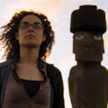I’m a Scientist is like school science lessons meet the X Factor! School students choose which scientist gets a prize of $1000 to communicate their work.
Scientists and students talk on this website. They both break down barriers, have fun and learn. But only the students get to vote.
This zone is the Organs Zone. It has scientists studying health and disease in various parts of our bodies. Who gets the prize? YOU decide!









Great question, Jaymeve!
I don’t know too much about vision, but i found this interesting explanation.
Our colour vision starts with the sensors in the back of the eye that turn light information into electrical signals in the brain – neuroscientists call them photoreceptors. We have a number of different kinds of these, and most people have three different photoreceptors for coloured light. These are sensitive to blues, greens and reds respectively, and the information is combined to allow us to perceive the full range of colours. Most colour blind men have a weakness in the photoreceptors for green, so they lose a corresponding sensitivity to the shades of green that this variety helps to distinguish.
At the other end of the scale, some people have a particularly heightened sensitivity to colour. Scientists call these people tetrachromats, meaning “four colours”, after the four – rather than three – colour photoreceptors they possess. Birds and reptiles are tetrachromatic, and this is what allows them to see into the infrared and ultraviolet spectra. Human tetrachromats cannot see beyond the normal visible light spectrum, but instead have an extra photoreceptor that is most sensitive to colour in the scale between red and green, making them more sensitive to all colours within the normal human range. To these individuals, it is the rest of us who are colour blind, as while most of us would be unable to easily distinguish an exact shade of summer-grass-green from Spanish-lime-green, to a tetrachromat it would seem obvious.
My brother and I are always arguing about things being different colours. For example, he claims his current pair on sunglasses are blue, but to me they look purple. So maybe we have different photoreceptors, too! 🙂
0
Your eye doesn’t simply see color — your brain creates it by drawing on knowledge of what things should look like.
I often spend weekends with my friends 2 year old boy Kazuki who is Japanese. Just last weekend we argued over whether a cement truck was blue or green. To me, the truck was certainly green, but Kazuki was adamant that it was green. His dad later told me that in Japanese, the word for blue (青 ao) is often used for colours that English speakers would refer to as green, such as the colour of a traffic signal meaning “go”. So language can change how we see!
The Himba tribe in Africa have very different categories for colours: they use “zoozu”, for instance, for dark colors, which includes reds, greens, blues, and purples, “vapa” for white and some yellows, “borou” for specific shades of green and blue. They lump together some colors for which we have distinct names, and they also discriminate other colors that we lump together as one. They even see greens that western eyes are not able to see. Their eyes discriminate green into more shades than we are able to. Perhaps green is more important for the Himba tribe?
Watch the story on this tribe here: https://www.youtube.com/watch?v=4b71rT9fU-I
1
Good question.
Putting the “whether we perceive different things as different colours argument” aside, and focusing on whether different people have different amounts of cells that sense colour, I’d say yes.
Hannah is correct in saying that some people have either less or more photoreceptor cells in the retina (the back of the eye) named cones and rods (cones being responsible for colour vision). To make matters even more complicated there are different types of cone cells!!! So some people have more/less of one type of cone cells will then see/perceive colours differently to others.
Hope this makes sense. It can get very confusing very quickly! LOL
0